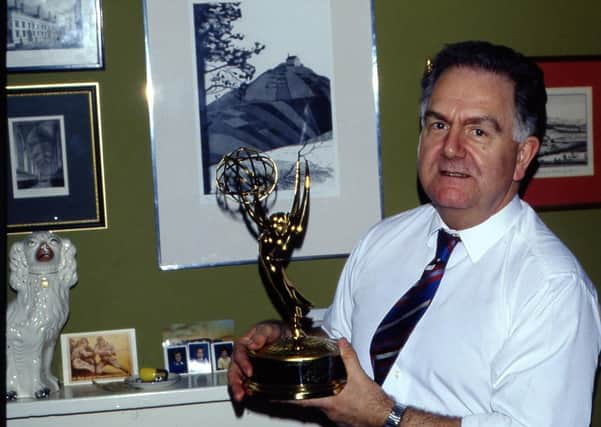Obituary: Alan Pattillo, Scottish writer and director who helped make Thunderbirds a hit


Although Gerry Anderson is the names most readily associated with the landmark children’s television show Thunderbirds, it was a Russian-language graduate from Aberdeen who called action on the very first episode 55 years ago. During a working relationship with Gerry Anderson that lasted almost quarter of a century Alan Pattillo worked as director, writer and script editor on such landmark shows as Thunderbirds, Fireball XL5 and Stingray.
Something of an all-rounder in the film and television business, Pattillo also wrote for the classic Swinging Sixties TV series The Avengers, with Diana Rigg, was an editor on Richard Attenborough’s Oscar-winning film Gandhi and won a Primetime Emmy award for his editing on a 1979 TV remake of All Quiet on the Western Front, with Richard Thomas from The Waltons.
Advertisement
Hide AdAdvertisement
Hide AdAlan Hutchison Pattillo was born into a well-off family in Aberdeen in 1929. He was the second son of Gladys (nee Glennie), who worked for an insurance company, and William Pattillo, who was company secretary at the Aberdeen Press and Journal. He was educated at Robert Gordon’s College in Aberdeen, read English at Aberdeen University and then studied Russian at Cambridge University.
He subsequently found himself caught up in the Cold War, working for an organisation that was widely dubbed “The School for Spies”. For his national service he worked at the Joint Services School for Linguists, which provided crash courses in Russian for military personnel in advance of the open hostilities that many thought imminent.
After national service Pattillo was keen to get into the film business and landed a job as an assistant to Alexander Korda, the great Hungarian émigré film producer and director. He trained as a sound editor and worked in that capacity at Warwick Films, a company set up by Cubby Broccoli, who later went on to produce the James Bond movies. His earliest credits were on the 1958 films Tank Force! with Victor Mature and Anthony Newley, and The Man Inside, a thriller with Jack Palance and Anita Egberg.
Pattillo first worked with Gerry Anderson in 1960 as a director and editor on Four Feather Falls. Although Anderson had worked on earlier puppet shows, Four Feather Falls was the first that he originated. A western featuring a sheriff voiced by Nicholas Parsons, it contained fantastic elements that Anderson and his team would develop in his run of classic sci-fi series.
Next up came the move into science-fiction and the fondly remembered series Supercar. Anderson and his core team, including Pattillo and his then-wife Sylvia Anderson, took puppetry to new levels of realism, with a technique Anderson christened “Supermarionation”, a portmanteau of “super marionette animation”. It employed very thin metal wires, which not only controlled the puppets but also carried signals that synchronised lip movements with dialogue.
The downside was that the heads contained the equipment and were overly large for the bodies. The puppet-makers could have made larger bodies too, but they would have been too heavy for the operators. And the puppets still walked in a jerky fashion, so Anderson determined they should spend as much time as possible in vehicles. The science-fiction genre provided scope to make vehicles as imaginative as possible and they became an essential part of the appeal – taking on the role of title character in each.
Pattillo was one of a small team of regular directors on Supercar and the subsequent series Fireball XL5, which was set in space, and Stingray, which was a submarine. They were aimed at children, but were becoming increasingly sophisticated, in terms of their storylines, engaging, colourful characters and puppetry techniques.
His work on Fireball XL5 was singled out for praise by Marcus Hearn in his 2015 book Thunderbirds: The Vault. “Added sophistication could be detected in the episodes directed by Alan Pattillo.”
Advertisement
Hide AdAdvertisement
Hide AdPattillo said: “We tried to do all kinds of experimental angles, with deep-focus photography, with the big heads in the foreground, and other characters talking to them in the distance, to give the feel of a comic-strip format.”
They scored their biggest and most enduring hit with Thunderbirds, the adventures of the Tracy family, who live on an island and are equipped with spacecraft and a submarine, all duly numbered for easy identification. They run International Rescue, not to be confused with the charity that David Miliband heads. Thunderbirds began in 1965, with Pattillo as writer, director and script editor. He shot the launch sequences that are used throughout the series.
Branching out, Pattillo came up with the plot for the Avengers episode The Bird Who Knew Too Much, in which a parrot is trained to memorise top secret information, and was sound editor on the cult film Performance, with Mick Jagger, and did an excellent job as editor on the excellent Jenny Agutter Outback drama Walkabout.
During the 1970s Pattillo worked regularly as editor on feature films, while continuing his association with Anderson, writing or directing episodes of Captain Scarlet, the live-action series UFO and Terrahawks.
After retiring in the 1990s Pattillo returned to Scotland to live in Banchory in Aberdeenshire. He remained active, researching his family history, a project that took him not only all over Scotland, but also to North America. He self-published two books, including Past and Present Company: A Family History of the Pittillochs. It seems that while many immigrants to the UK anglicised their names, Pattillo’s forebears managed to abbreviate their name in a way that turned it from a Scottish-sounding name into an Italian-sounding one.
Latterly he moved to Salisbury, where he lived in the same retirement complex as his brother John, who survives him. He died of complications from Parkinson’s disease. He never married or had children.
Brian Pendreigh
Comments
Want to join the conversation? Please or to comment on this article.